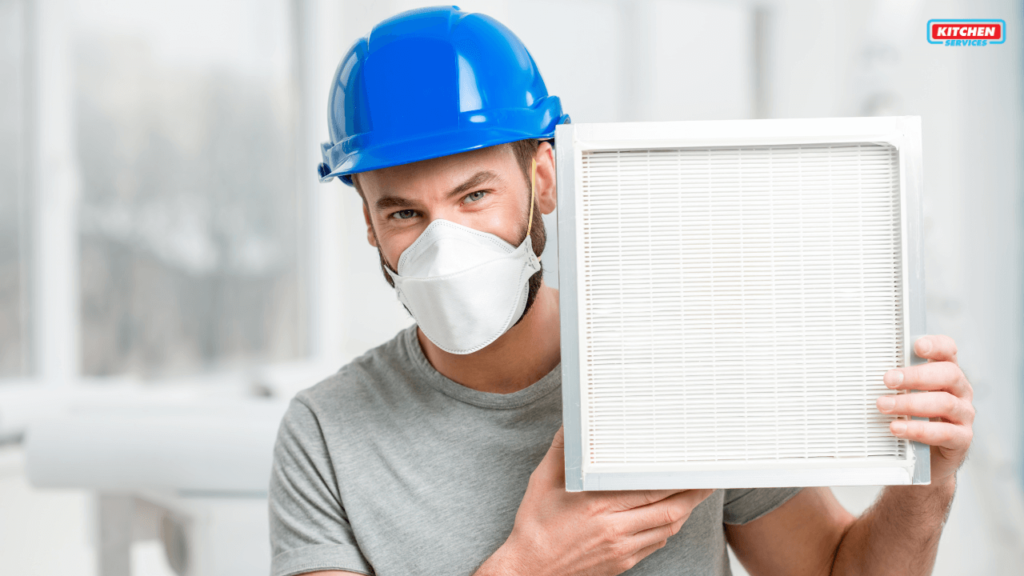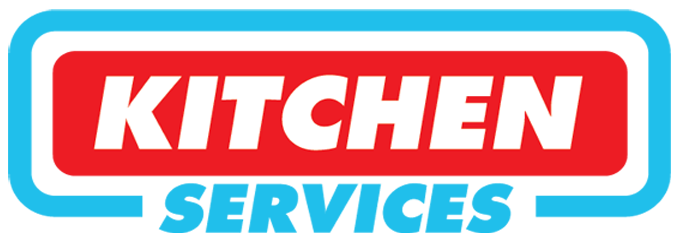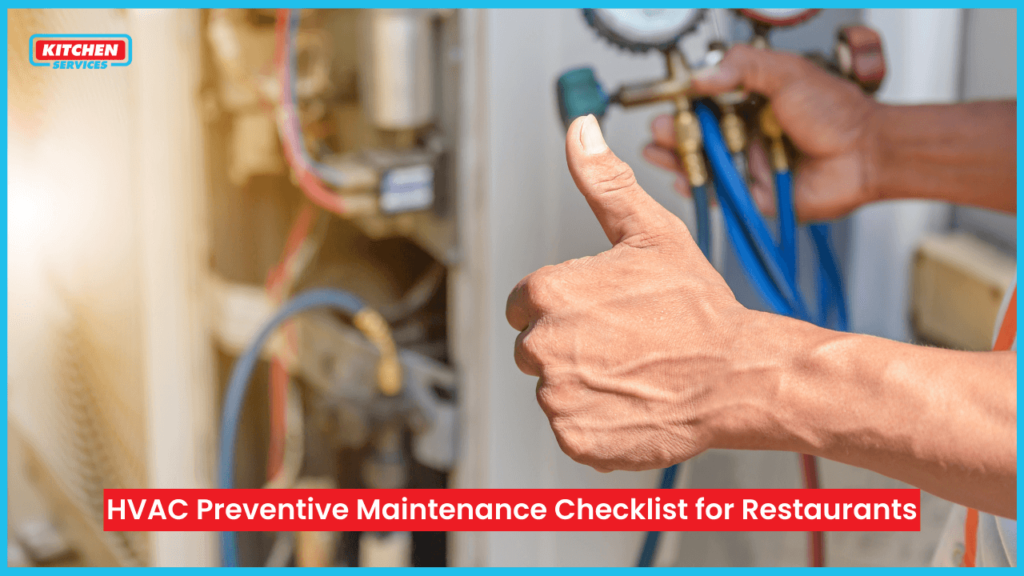HVAC systems are really important for maintaining high-quality standards in restaurants! Unfortunately, it seems like some restaurants may overlook the importance of maintaining their systems which leads to unexpected expenses down the road.
A fully functioning HVAC system help preventing food spoilage and enhance employee productivity at the restaurant by providing a comfortable working environment.
We’ve got a helpful guide on HVAC preventive maintenance checklist for restaurants. You can follow the HVAC preventive maintenance checklist template to prevent any major breakdowns. Let’s get started!
HVAC Preventive Maintenance Checklist for Restaurants

A comprehensive HVAC maintenance checklist should include a well-defined plan that you must follow to ensure the system operates smoothly around the clock. The goal is to identify the problems before they occur. Because even a minor issue should be your top priority of the day.
Let’s have a look at some key elements in the restaurant maintenance checklist.
Air Filters
The Heating and Cooling system of a restaurant depends a lot on the condition of the air filters. Even a small blockage will not let the air conditioners work properly. Therefore, it is crucial to check the air filters at least once every three months if any replacement or repair is needed. Washing your air filters regularly will also help to maintain the temperature of the thermostat.
Visual Inspection
Unusual noises from any machine or component of the HVAC system are something not to overlook at all. So make sure to fix or replace any screws, latches, or gaskets. Also, Check for any cracks or breaks in the duct connectors. Instead of trying to fix things on your own, it’s better to call professionals to do their job.
Exhaust Fans
Exhaust fans in the cooking areas of a restaurant have a huge impact on the ventilation system. Good and strong ventilation is essential to keep the atmosphere comfortable for breathing. Therefore, it’s mandatory to inspect and clean any kind of grease or dirt on them on a regular basis.
Condenser
The efficiency of condensers impacts the energy expenses. A clean condenser ensures the HVAC system is working effectively. To ensure the HVAC condensers work at their best, it’s essential to remove any kind of obstacles that can affect the condenser’s performance. Regular cleaning and maintenance of the condenser coils and parts around it will surely reduce the risk of any unknown breakdown in the system.
Drain Lines
Over time, certain types of debris like algae, leaves, or dust tend to accumulate in the drain lines of the HVAC system. This acclamation becomes a major cause of blockage in the drainage system. Therefore, it’s crucial to have regular maintenance to prevent any kind of growth in the drain lines. One way to address this issue is to use bleach in your maintenance routine which will inhibit the growth of such substances in drain lines.
Outdoor Unit
Outdoor units are as important as indoor units. These units are responsible for dissipating heat or absorbing it from the surroundings. Therefore, it is crucial to have regular maintenance of outdoor units of the HVAC system to prevent any kind of blockage that might disrupt the flow of air and hinder the system’s ability to maintain a constant temperature.
Regular Lubrication of Moving Parts
Lubricating the moving parts like motors or fans is also a key element of the HVAC Preventive Maintenance Checklist for Restaurants. These parts create friction on working that can lead to wear and tear on the components over time. Therefore, lubrication plays a crucial role in ensuring the smooth working of the system. Here are the top benefits of lubrication:
- It creates a protective layer between these parts, reducing friction and minimizing the damage caused by any movement.
- Increases the lifespan of the components.
- Improves efficiency
- Prevents any kind of overheating due to friction.
Waste Bins
This is the area that is responsible for keeping the atmosphere clean and hygienic. Make sure to keep the waste bin bags on a daily basis. Also, clean your waste bins every once a week for any kind of dirt that may cause a bad smell in the restaurant.
Why is HVAC Maintenance Critical?

Regular maintenance is essential for the HVAC system for several reasons:
Low Energy Bills
Boilers, Furnaces, and air conditioners can consume a lot of energy to provide the best performance. Regular maintenance of the HVAC system reduces the amount of energy for it to operate smoothly and effectively. When components like filters, coils, and fans are well-maintained, they tend to use less energy which reduces utility bills
Low Repair Cost
Identifying the minor issue before it turns into a major breakdown can help save time and money for the repair process.
Extended Lifespan
A well-maintained HVAC system will have less wear and tear than the one not maintained at all. Proper maintenance will help prolong the lifespan of the components of the HVAC system and will have easier time to work smoothly and effectively.
Improve Air Quality
The indoor air quality depends a lot on the efficiency of the HVAC system. Cleaning and replacing air filters to remove any kind of dust or blockage plays a key role in maintaining a constant temperature.
Safety
A well-maintained HVAC system will reduce the risk of any fire hazards due to any sort of leakage. This is important not only for the ones working near the HVAC system but also for those working in the same building.
What Areas Are Included in Restaurant Preventive Maintenance?
An effective Restaurant Preventive Maintenance more than providing ambiance and food. Rather it covers a wide range of equipment that needs regular maintenance to ensure the efficiency of the system. When creating an HVAC preventive maintenance checklist for restaurants, make sure to focus on these key areas:
- Kitchen Equipment: Ovens, grills, refrigerators, fryers, and other kitchen appliances.
- Electrical Components: Lighting, wiring, circuit breakers, etc
- Fire Safety Equipment: Fire Extinguishers, Sprinkle detectors, smoke detectors, and fire exits.
- Exhaust Fans: Keep exhaust hoods and ventilation system clean
- Plumbing and Drains: Sinks, faucets, and drains to check if there is any water blockage
- Waste Management: Dispose of trash bags and clean bins to prevent pet infestations
Air Conditioner Preventive Maintenance Checklist for Restaurants
- Inspect Filters: Check and clean or replace air filters every 1-3 months to ensure optimal airflow and air quality.
- Clean Coils: Clean evaporator and condenser coils regularly to maintain efficiency and prevent overheating.
- Check Refrigerant Levels: Ensure refrigerant levels are adequate and look for any leaks that could impact performance.
- Examine Ductwork: Inspect ductwork for leaks, blockages, or damage that could reduce system efficiency and airflow.
- Test Thermostat: Verify that the thermostat is functioning correctly and accurately reading temperatures.
- Inspect Electrical Components: Check electrical connections, wiring, and components for wear or damage to prevent potential failures.
- Lubricate Moving Parts: Apply lubricant to moving parts such as fans and motors to reduce friction and wear.
- Clear Drain Lines: Ensure that drain lines are clear of obstructions to prevent water damage and mold growth.
- Check System Calibration: Ensure the system is properly calibrated for optimal temperature control and efficiency.
- Inspect Insulation: Verify that insulation on refrigerant lines is intact and properly maintained to enhance efficiency.
- Examine Fan Blades: Inspect fan blades for damage or debris and clean as necessary to maintain proper airflow.
- Review Condenser Unit: Check the condenser unit for debris, ensure it’s clear of obstructions, and clean the area around it.
- Test System Operation: Run the system through a full cycle to ensure it operates smoothly and efficiently without unusual noises or issues.
Refrigeration Maintenance Checklist for Restaurants
- Inspect Temperature Settings: Verify that the thermostat is set to the appropriate temperature for the type of refrigeration (e.g., 38°F for refrigerators, -10°F for freezers).
- Clean Condenser Coils: Regularly clean condenser coils to prevent dust and debris buildup, which can reduce efficiency and increase energy consumption.
- Check Evaporator Coils: Ensure evaporator coils are clean and free from ice buildup, which can affect cooling performance.
- Inspect Door Seals: Check door gaskets and seals for damage or wear. Replace if necessary to prevent air leaks and maintain efficiency.
- Test Refrigerant Levels: Ensure refrigerant levels are adequate and look for any leaks. Low refrigerant can impact cooling performance.
- Examine Drain Lines: Clear and clean drain lines to prevent blockages and water buildup that can cause mold and damage.
- Check Fan Operation: Inspect both condenser and evaporator fans to ensure they are operating correctly and are free of obstructions.
- Inspect Electrical Components: Check wiring, connections, and electrical components for signs of wear or damage to prevent potential failures.
- Verify Defrost Cycle: Ensure the defrost cycle is operating correctly to prevent excessive frost buildup on evaporator coils.
- Lubricate Moving Parts: Apply lubrication to moving parts such as fan motors and compressor components to reduce friction and wear.
- Inspect Refrigerant Lines: Check insulation on refrigerant lines and repair or replace any damaged sections to maintain efficiency.
- Clean Interior Surfaces: Regularly clean the interior surfaces of the refrigeration unit to maintain hygiene and prevent contamination.
- Check System Alarms: Test and ensure that all alarms and safety features are functioning correctly.
Conclusion:
A well-structured HVAC preventive maintenance checklist for restaurants is a cornerstone of successful operations. By paying attention to critical components like air filters, exhaust fans, condensers, drain lines, outdoor units, lubrication, and waste bins, you can ensure your restaurant maintains a comfortable environment, saves on energy costs, and operates efficiently. Regular maintenance is not just a cost-saving measure but also a commitment to safety and quality in your restaurant.
FAQs:
1. How often should I check the air filters in my restaurant’s HVAC system?
Air filters in a restaurant’s HVAC system should be checked at least once every three months. Regular inspection ensures they are free from blockages, allowing the system to maintain a consistent temperature. Consider washing the filters regularly to enhance their efficiency.
2. Can I handle HVAC maintenance tasks on my own?
While some minor maintenance tasks can be handled independently, it’s generally advisable to call in HVAC professionals for repairs and more complex maintenance. Professionals have the expertise and equipment to ensure the job is done correctly, minimizing the risk of further damage.
5. What role does lubrication play in HVAC maintenance?
Lubricating moving parts like motors and fans is a crucial aspect of HVAC preventive maintenance. It reduces friction, prolongs component lifespan, improves efficiency, and prevents overheating. Regular lubrication helps keep the system running smoothly and minimizes wear and tear.
What are restaurant preventive maintenance best practices?
Restaurant preventive maintenance best practices include regular inspections of equipment, such as HVAC systems, refrigeration, and kitchen appliances. Establish a routine schedule for cleaning, servicing, and repairing to prevent breakdowns. Train staff to recognize and report issues early, maintain detailed records of all maintenance activities, and adhere to manufacturer recommendations and local health codes.
What are restaurant maintenance schedules?
Restaurant maintenance schedules are planned timelines for inspecting, cleaning, and servicing various equipment and systems within the restaurant. These schedules include daily, weekly, monthly, and annual tasks, such as checking refrigeration temperatures, cleaning exhaust systems, and servicing HVAC units. Regular adherence to these schedules helps ensure equipment efficiency, compliance with health regulations, and a safe, operational environment.

